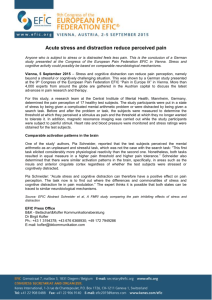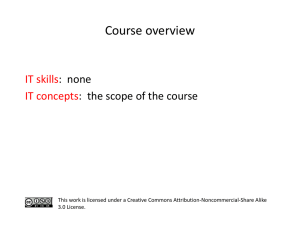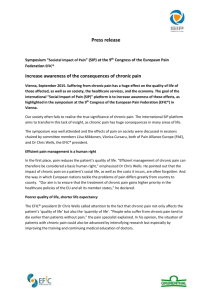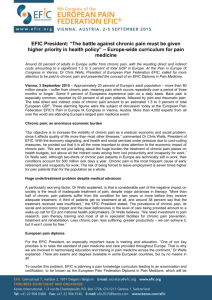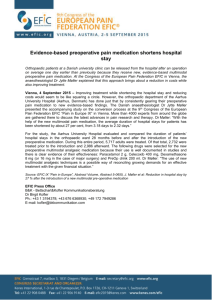Assessing the efficacy of pain therapies
advertisement
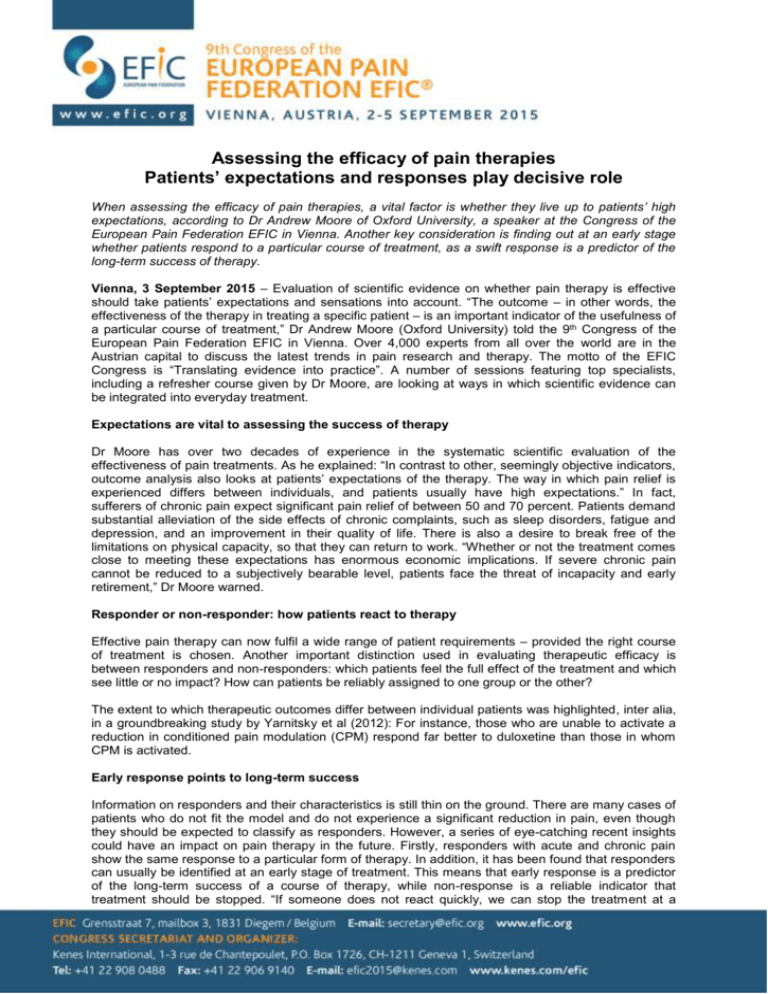
Assessing the efficacy of pain therapies Patients’ expectations and responses play decisive role When assessing the efficacy of pain therapies, a vital factor is whether they live up to patients’ high expectations, according to Dr Andrew Moore of Oxford University, a speaker at the Congress of the European Pain Federation EFIC in Vienna. Another key consideration is finding out at an early stage whether patients respond to a particular course of treatment, as a swift response is a predictor of the long-term success of therapy. Vienna, 3 September 2015 – Evaluation of scientific evidence on whether pain therapy is effective should take patients’ expectations and sensations into account. “The outcome – in other words, the effectiveness of the therapy in treating a specific patient – is an important indicator of the usefulness of a particular course of treatment,” Dr Andrew Moore (Oxford University) told the 9th Congress of the European Pain Federation EFIC in Vienna. Over 4,000 experts from all over the world are in the Austrian capital to discuss the latest trends in pain research and therapy. The motto of the EFIC Congress is “Translating evidence into practice”. A number of sessions featuring top specialists, including a refresher course given by Dr Moore, are looking at ways in which scientific evidence can be integrated into everyday treatment. Expectations are vital to assessing the success of therapy Dr Moore has over two decades of experience in the systematic scientific evaluation of the effectiveness of pain treatments. As he explained: “In contrast to other, seemingly objective indicators, outcome analysis also looks at patients’ expectations of the therapy. The way in which pain relief is experienced differs between individuals, and patients usually have high expectations.” In fact, sufferers of chronic pain expect significant pain relief of between 50 and 70 percent. Patients demand substantial alleviation of the side effects of chronic complaints, such as sleep disorders, fatigue and depression, and an improvement in their quality of life. There is also a desire to break free of the limitations on physical capacity, so that they can return to work. “Whether or not the treatment comes close to meeting these expectations has enormous economic implications. If severe chronic pain cannot be reduced to a subjectively bearable level, patients face the threat of incapacity and early retirement,” Dr Moore warned. Responder or non-responder: how patients react to therapy Effective pain therapy can now fulfil a wide range of patient requirements – provided the right course of treatment is chosen. Another important distinction used in evaluating therapeutic efficacy is between responders and non-responders: which patients feel the full effect of the treatment and which see little or no impact? How can patients be reliably assigned to one group or the other? The extent to which therapeutic outcomes differ between individual patients was highlighted, inter alia, in a groundbreaking study by Yarnitsky et al (2012): For instance, those who are unable to activate a reduction in conditioned pain modulation (CPM) respond far better to duloxetine than those in whom CPM is activated. Early response points to long-term success Information on responders and their characteristics is still thin on the ground. There are many cases of patients who do not fit the model and do not experience a significant reduction in pain, even though they should be expected to classify as responders. However, a series of eye-catching recent insights could have an impact on pain therapy in the future. Firstly, responders with acute and chronic pain show the same response to a particular form of therapy. In addition, it has been found that responders can usually be identified at an early stage of treatment. This means that early response is a predictor of the long-term success of a course of therapy, while non-response is a reliable indicator that treatment should be stopped. “If someone does not react quickly, we can stop the treatment at a relatively early stage and try a different approach. This saves patients from undergoing long drawn-out treatment that only results in potential side effects,” Dr Moore concluded. With this in mind, he suggests reviewing conventional procedures for testing the efficacy of pain medication, as well as drawing up recommendations that allow doctors to correctly identify responders in practice. Fewer medications, improved effectiveness Another study (Demant et al, 2014) demonstrates how important accurate classification can be. The results showed that irritable nociceptors are central to the effectiveness of painkillers such as oxcarbazepine, which act as sodium channel inhibitors. It was found that an average of seven medications were required to achieve pain reduction of over 50 percent in the patients observed in the study. Those with irritable nociceptors needed only four different drugs, but for those without the number was 13. “These findings underline the importance of accurate patient phenotypes. The clearer the patient profile, the fewer medications are required,” Dr Moore explained. This would also help to cut unnecessary spending on treatment, as well as prompting a reappraisal of current practice in relation to drug availability. Many countries in Europe have formularies – positive lists of pharmaceuticals for which public funds bears the costs or negative lists which exclude certain medications from the services provided by health insurance funds or health authorities. Most of these bodies use evidence-based criteria when compiling such lists. However, Dr Moore sees a problem in such limited formularies. Speaking at the EFIC Congress he put forward an alternative concept: “I am in favour of specifying the number of medications that have to be included in a formulary, so that all suitable patients can receive effective treatment for certain types of pain.” Sources: EFIC Abstract C09 Refresher Courses: Moore, Effectiveness and adverse effects of pain medications: Lessons from 20 years experience of systematic reviews in pain management; Moore et al. Duloxetine use in chronic painful conditions – individual patient data responder analysis. European Journal of Pain 2014;18:67-75 EFIC Press Office B&K - Bettschart&Kofler Kommunikationsberatung Dr. Birgit Kofler Ph.: +43 1 3194378; +43 676 6368930; +49 172 7949286 E-mail: kofler@bkkommunikation.com

